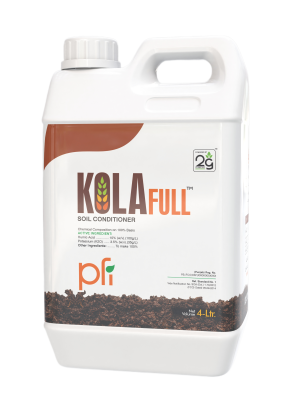Description
KOLA: Soil Conditioner Humic Acid 40%, Potassium (K2O) 7% (w/w) is a specialized product designed to improve soil health and enhance plant growth. Here are the key features and benefits of this soil conditioner.
Key Features & Benefits:
- High Concentration of Humic Acid:
- Contains 40% humic acid, which is a natural organic compound derived from decomposed plant and animal matter.
- Humic acid enhances soil structure and nutrient availability.
- Potassium Content:
- Contains 7% potassium (K), an essential nutrient for plant growth.
- Potassium plays a crucial role in various physiological processes, including photosynthesis, water regulation, and disease resistance.
- Organic Matter:
- Increases the organic matter content in the soil, improving its overall health.
- Enhances microbial activity, which is vital for nutrient cycling and soil fertility.
- Compatibility:
- Can be used in combination with other fertilizers and soil amendments, providing flexibility in nutrient management.
- Versatile Application:
- Suitable for a wide range of crops, including grains, vegetables, and fruit trees.
- Can be applied through soil incorporation, foliar spray, or irrigation systems.
- Improved Soil Structure:
-
- Enhances soil aeration and drainage, promoting root development and growth.
- Reduces soil compaction, allowing better root penetration.
- Enhanced Nutrient Availability:
-
- Increases the availability of macro and micronutrients, including nitrogen, phosphorus, and potassium.
- Helps in the chelation of nutrients, making them more accessible to plants.
- Increased Water Retention:
- Improves the soil’s ability to retain moisture, reducing irrigation frequency and promoting drought resistance.
- Enhances the soil’s capacity to hold nutrients, preventing leaching.
- Stimulated Microbial Activity:
- Promotes beneficial microbial populations in the soil, enhancing organic matter decomposition and nutrient cycling.
- Improves overall soil health and fertility.
- Enhanced Plant Growth and Yields:
- Supports healthy plant growth by providing essential nutrients and improving soil conditions.
- Can lead to increased crop yields and better-quality produce.
- Environmental Benefits:
- Reduces the need for chemical fertilizers, promoting sustainable agricultural practices.
- Helps mitigate soil erosion and degradation, contributing to long-term soil health.
- Disease Resistance:
- Strengthens plants’ resilience to pests and diseases, promoting better crop health.



